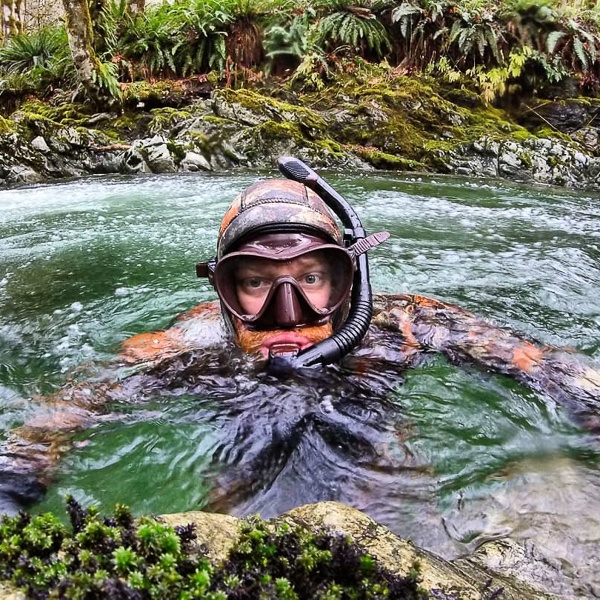Observations of a river snorkeler
“The power of the fish, of the river, it’s an awesome encounter’ – Chris Walling
By SeaWestNews
Chris Walling of Vancouver Island has a strong understanding of the importance of wild salmon, and firmly believes that a responsible and successful salmon farming industry is vital for the wild Pacific fisheries. He goes to great depths to help improve the understanding of how wild and farmed fish can co-exist for a sustainable future.
Tell us about your adventures over the last year.
It was an interesting year. I dedicated more time than ever snorkelling our island streams. My log book tallied 520hrs and 37 streams from Sayward to Duncan and areas flowing into the Nootka Sound, and with the reach of social media, I’ve been able to build a network of knowledgeable outdoorsmen from Alaska to California.
Was there a sole focus for you?
This year my interest was focused on our Chinook salmon. The Chinook has been popularized lately because of its importance in diet to the South Resident Killer Whales (SRKW). The fact that they are/were available year- round defines the importance as a food source for the SRKW.
What time of year is their spawning season?
Chinook salmon spawn in the fall, but there are populations that enter certain rivers almost year-round. The spring run Chinook was the dominant return on many streams and is the source of the nickname “spring salmon”. Most of the spring and summer run Chinook are near extinction and have been for a long, long time. However, not all is lost.
I observed 3 rivers with recordable returns of spring Chinook on the East coast of Vancouver Island in 2018. Last year I sampled 13 populations on Vancouver Island regularly from August-November.
What was the most surprising observation of the chinook salmon, for you?
Chinook are amazing. The power of the fish, of the river, it’s an awesome encounter, when fresh from the ocean they travel through the deepest fastest parts of the river.
What was your conclusion on the strength of the runs?
Most runs were very strong. Observations from others also support my findings that 2018 Vancouver Island Chinook returns were strong.
And your overall observation?
My observations of Chinook salmon in the Fraser and Columbia river basin which are so essential to South Resident Killer Whales survival, is that they are in a serious decline. Especially important for the SRKW survival is the Snake River, a tributary of the Columbia, which produces a high-fat content, early run spring Chinook that is vital to the maternity health.
However, 16 dams block passage for spawning adults and out-migrating smolts. On the Fraser, heavy development of the estuary, sewage, agricultural runoff, rampant habitat destruction such as the 1914 CNR rock slide at Hells Gate and the draining of the Sumas Lake have forever altered the river and its salmon.
As a summary, 2018 was a year of drastic Chinook salmon fluctuations in the Pacific Northwest and that has been the trend for the last decade. We need to take a look at salmon returns from Alaska all the way to California before forming opinions on causes of success and failure.
The struggle of some returns in North America seem to have obvious culprits like drought in California, runoff pollution in the Fraser, and hydro dams on the Columbia. However, there are salmon returns that are struggling in isolated areas that are far removed from likely suspects.
Is there anything you would like to say to our readers?
Here’s something I will leave you with. What’s causing the collapse of Chinook salmon in rivers like the Taku and Stikine in Southeast Alaska? Observers in Alaska are not blaming salmon farms, that’s for sure.
For stunning images and videos of Chris Walling’s adventures, check out his feed on Instagram @steel_snorkel
RELATED STORIES
‘Aquaculture one of the best ways to save wild salmon’
